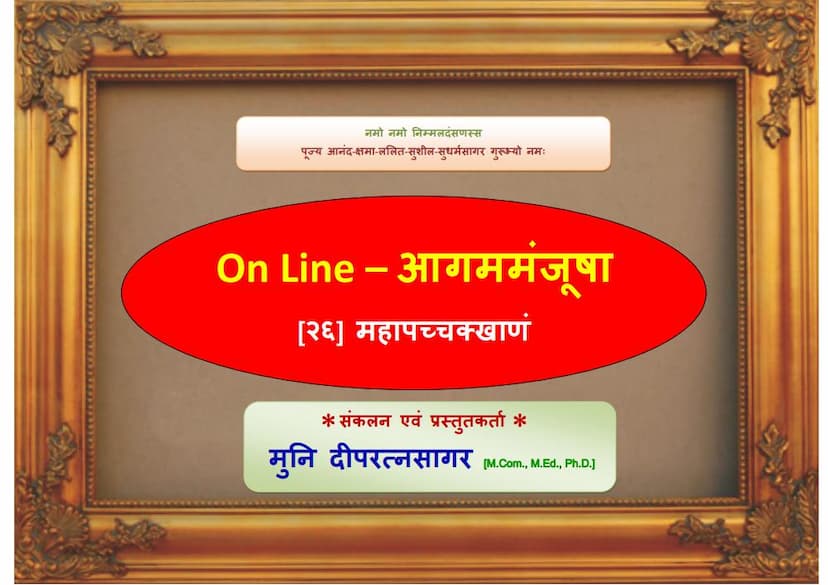Aagam Manjusha 26 Painnagsuttam Mool 03 Mahapachakhan
Added to library: September 1, 2025

Summary
Here's a comprehensive summary of the provided Jain text, "Aagam Manjusha 26 Painnagsuttam Mool 03 Mahapachakhan," based on the given pages:
This document is an "Online-Aagam Manjusha," a digital rendition of a compilation of Jain scriptures originally edited by Acharya Anand Sagar Suriji about 70 years prior to the 2012 publication date. The current editor, Muni Deepratnasagar, presents this online version with some useful changes and additions to the original compilation.
The preface highlights that the original "Aagam Manjusha" served as a guiding light for 70 years, and this online version aims to continue that tradition. The editor notes some variations in the current online compilation compared to the original, specifically mentioning the inclusion of "Niryukti" alongside "Mool Sutra" in the Avashyak Sutra, "Bhashya" with "Mool Sutra" in the Jitkalpa Sutra, the optional "Panchakalpa" with its "Bhashya," the inclusion of "Pind Niryukti" as an alternative to "Ogh Niryukti" (though with a changed printing location), and the inclusion of the Kalpa (Barasa) Sutra. The contact information for Muni Deepratnasagar is also provided.
The core of the document is the Mahapachakhan (Great Renunciation or Great Resolution). It begins with salutations to the enlightened beings and the Omniscient ones. The text then proceeds to outline a comprehensive path of spiritual practice and renunciation, emphasizing the following key themes and practices:
1. Renunciation and Equanimity:
- Universal Forgiveness: The text stresses the importance of seeking forgiveness from and forgiving all beings.
- Renunciation of Attachments: It advocates for the renunciation of attachments to the body, possessions, and sensory pleasures, both internally and externally, through mind, speech, and body.
- Overcoming Negative Emotions: A significant portion is dedicated to renouncing anger, pride, deceit, greed, lust, hatred, attachment, aversion, joy, sorrow, fear, and all other forms of emotional disturbance.
- Abandoning Worldly Illusions: The text emphasizes recognizing the transient nature of worldly possessions, relationships, and even the body itself. It speaks of understanding the impermanence of all worldly affairs.
2. Self-Discipline and Observance:
- Repentance and Confession: The text highlights the practice of confessing and repenting for one's wrongdoings and omissions in observing the vows and disciplines.
- Self-Reliance and Solitude: It promotes the understanding of oneself as alone in the cycle of birth and death, emphasizing that each soul experiences the consequences of its actions independently.
- Renunciation of the Non-Self: The text guides the practitioner to understand that external states, including those related to the body and possessions, are temporary and not the true self.
- Abstinence from Unrighteousness: It calls for renouncing impure conduct, falsehood, theft, excessive desire, and all other unrighteous actions.
3. The Path to Liberation:
- The True Self: The text identifies the true self as the soul possessing pure knowledge and perception, which is eternal.
- Detachment from Worldly Connections: It reiterates the need to renounce worldly connections, which are the root cause of suffering.
- Renunciation of Ignorance and Delusion: The practice involves renouncing ignorance, delusion, and the false beliefs that lead to attachment.
- The Importance of Right Faith, Knowledge, and Conduct: The text underscores the significance of right faith (Samyak Darshan), right knowledge (Samyak Gyan), and right conduct (Samyak Charitra) as the pillars of spiritual progress.
- Austerities and Meditation: Austerities (Tapas) and meditation (Dhyana) are presented as crucial practices for purifying the soul.
4. The Nature of Suffering and Karma:
- The Cycle of Birth and Death: The text vividly describes the endless cycle of birth, death, old age, and suffering in various realms of existence (hells, animals, humans, gods).
- The Consequences of Actions: It emphasizes that karma is the sole cause of suffering and that one must bear the fruits of one's actions.
- The Insatiability of Desires: The text illustrates how worldly desires, whether for sensory pleasures, wealth, or status, are never truly satisfied, leading to a continuous cycle of suffering.
5. The Ideal Death (Pandit Maran):
- Conscious Preparation for Death: A significant portion of the text focuses on the importance of Pandit Maran, or the death of the wise and prepared. This is achieved by reflecting on the impermanence of life, the suffering of worldly existence, and the consequences of past actions.
- Meditating on the True Self: The ideal death involves meditating on the true, eternal self, free from worldly attachments and emotional disturbances.
- The Role of the Guru: The text implicitly suggests the importance of guidance from a spiritual teacher in understanding and practicing the path to a wise death.
6. Specific Practices for Renunciation:
- Observing the Mahavratas: The text emphasizes adhering to the five great vows (Mahavratas) with pure intention and disciplined conduct.
- Control of the Senses: It calls for the control of the five senses and the renunciation of sensual pleasures.
- Purification of Thoughts and Speech: The text advocates for purity of mind, speech, and actions, renouncing all negative thoughts, gossip, and harmful speech.
- The Ultimate Goal: The ultimate goal is to achieve liberation (Moksha) by eradicating all karmic impurities.
The document concludes with the idea that by following these principles, a practitioner can achieve a state of peace and ultimately attain liberation, either in this life or in a few future lives. It stresses the importance of consistent effort, devotion to the teachings of the Jinas, and overcoming all obstacles through inner strength and wisdom.